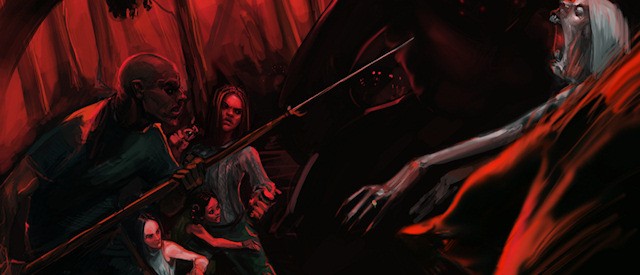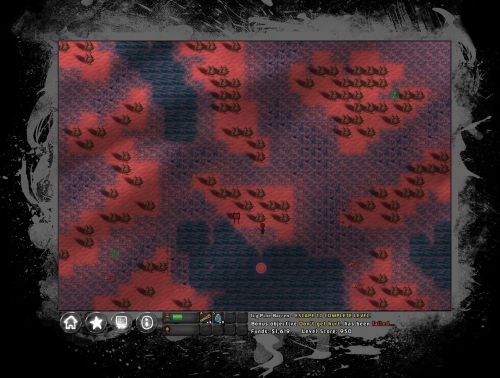

Shattered Haven is not your typical zombie survival game. You don’t spend most of the adventure staring down the barrel of a gun wondering if ammo or foes lay around the next corner. In the background to all that is forgettable story that barely functions as an excuse for all the mayhem that’s been unleashed. Shattered Haven, instead, seeks to deliver a compelling narrative through the game’s main characters while focusing the action on having you determine the correct way to get to the weapon that’s around the corner, rather than wondering if there is one. In many ways, it feels a lot like an old NES top-down scroller, like Lifeforce, StarTropics, or Fester’s Quest. (Ok, so the last one is just a litmus test for all you old-school gamers out there, but the others apply.) The overall narrative seems to strive for some of the same notes of family bonds and strength of humanity in the face of hardship that Telltale Games’ The Walking Dead hit so well. While Shattered Haven does a lot that is refreshing and new for a zombie survival game, it just doesn’t have that level of polish that would really put it over the top.
For nine years a man, his wife, and their daughter have lived in a sheltered compound while the “Grays” roam the world around them. One day, the man finds a woman and her son while foraging for supplies and everything pretty much goes wrong from there. The boy and daughter get separated from the man and his wife, who are now trying to track them down and, hopefully, achieve some semblance of normalcy again. Each half of this family will have its own set of adventures that reveal a little something about the world in which they find themselves. Your group will grow and you’ll have to care for these people using the money that you collect from completing levels to buy food and supplies. Not everyone can be saved, though…
The game’s action is perhaps best placed into the “environmental puzzler” category. Each of the game’s 100 levels will challenge you to eliminate all the “Grays” in an area using the weapons and other hazards that are presented to you. Occasionally you get a little bit of a leg up as some of these levels take place within the same world as the characters. This means that any objects, such as an axe or hammer, which you bring with you into the level, can be used there. Likewise, any tools you find can be taken back into the “overworld.” Many of these levels, though, take place in a separate sort of dimension where you can only use what’s presented to you and nothing comes back.
This screen was capped from a game that was running at a 1920x1280 screen resolution and then resized down
For example, in one of these levels there are ten “Grays” in the area that have to be eliminated. These particular types of “Grays” wander around the level in a fairly set pattern and pay no attention to the characters (unless they happen to get in the way). None of the usual weapons (anything made of iron or water) are present to use against them. There are, however, levers hidden amongst the beds of flowers that make up the scenery, which set off environmental traps to eliminate these undead. Trigger these levers at the right time to ensure the walking dead become a whole lot less ambulatory and then make it to the exit before a mysterious force chases you down and ends it all for you.
Other levels will have you going across one or more screens to find additional items or weapons to use, but the overall goal never really changes. There are bonus objectives, such as not taking any damage or killing certain grays before others, that you can attempt to complete for an added challenge and, more importantly, bonus money. These help to add some challenge and replay options, but it’s not quite enough. From a single-player perspective, it feels like there are just too many levels where your objective - collect weapons and kill the grays - is the same. Portal and Portal 2 both could be accused of the same fault, but they managed to overcome it by introducing some new mechanic with each “test chamber” that forces the player to constantly be thinking up new solutions. Shattered Haven, unfortunately, has no such mechanic when playing through the game alone.
Playing with a friend, though, seems to be the mechanic that the game’s developers hoped would keep things fresh. And it certainly manages it for a while.
Shops like these are important for buying some much needed supplies in between levels
Shattered Haven, like all of Arcen Games’ titles, supports co-op play; in this case, two player local with drop-in/drop-out. Throughout the single-player game, you’ve always got another person tagging along with you. In some of the levels, you may even find yourself wishing that you could switch to that other person to either lure some of the “Grays,” or to go and get that object while you’re busy doing something else. In other words, the game feels like you should be playing it with a friend.
When playing cooperatively, the levels themselves don’t change in any significant way. Yes, there is a slight increase in the number of enemies in the level and there are two of some items so that each player can participate; but the goal stays the same. What changes is the way in which you go about achieving that goal.
As mentioned before, the second player can act as a decoy to lure some of the undead away from an area to which you need access, or they can slip past to get that one piece of equipment you both need. It may not seem like much, but it can really count when you need it to. There are number of different “Grays” that you’ll face along the way and they each behave in a slightly different fashion. One, appropriately called a “Seeker,” will follow your path as you run from it. This trait is hardly noticeable until you cross a puddle of water and it suddenly stops rather than go around. The second you go back to the other side of it, it will resume following you. With a second player there, he or she can go grab a weapon and set a trap for the zombie that you lead it into perfectly. It’s nothing terribly clever, yet it’s clever enough that you and your partner feel like you are.
From a co-op perspective, that’s really what the game is all about – working with your partner to outwit the game. For any new given level, you’ll take a look at the latest situation in which you’ve been placed, figure out how you can either clear it or make it to the next screen, and then execute it. It is a solid formula. When I played the game alone, I got through about four or five levels before I started feeling like it was a chore. When I was playing with a friend, I found myself more focused on getting to the next one so we could devise a new strategy. The repetition would occasionally still manage to creep its way into the play session, but it was far less noticeable when you’ve got a friend there to keep things interesting.
Spot the correct path to the scythe
While I was glad for the company, having a second player along for the ride made me more aware of another issue with the game: being able to keep track of your character. The top-down perspective provides a great view from which you can see the whole field and plan out your strategy. From such great heights, though, it can be easy to lose where you are or where you’re headed. The playable characters are distinct enough that I didn’t mistake myself for the other one, but I did mistake my co-op partner for a “Gray” a couple of times (and vice versa). It’s not just the characters, either.
I sometimes found myself going through a maze of obstacles to go and grab something only to realize too late that the object was actually on the other side of the hedge where I was currently standing. Oh, and there were zombies behind me. You may say, “well that’s the point of a maze” and I would agree. However, the confusion in this case was due less to the intent of the object/obstacle placement, and more a result of obstacles blending together with the background to make it hard to spot what’s a path and what isn’t. When you have to start a level over again because of this issue, it’s just a silly mistake that you laugh off and do better the next time. When it happens three or four times, it becomes frustrating. I will be fair and say that on the Shattered Haven website, under System Requirements, they do say that a 1024x768 screen resolution is recommended. When playing on this resolution, it definitely helps to make certain things clearer, though it's not always enough.
There’s a lot about Shattered Haven I really like: the overall gameplay, the way co-op is integrated, the fun of clearing a level with a friend, and the narrative mysteries that leave you wondering what exactly is going on. Each piece is good and yet I can’t help but feel that perhaps they could be a bit more. The co-op experience, while fun, could do something with the players interacting with one another beyond luring zombies. There are glimpses of this in a few of the levels, such as toggling the switches to kill the “Grays,” and they serve as a welcome change of pace. Maybe a few of the levels could twist some of their set rules to change things up just a bit to ease with the repetition.
Shattered Haven is one of those games that when it’s on, it’s on all the way thanks to its clever level designs, interesting objectives, and a different way of tackling the undead menace. When those elements are lacking, though, the game only manages to walk at a pace a little faster than that of the average “Gray.”
The Co-Optimus review of Shattered Haven is based on the PC version of the game. A copy of the game was provided by the publisher for review purposes.